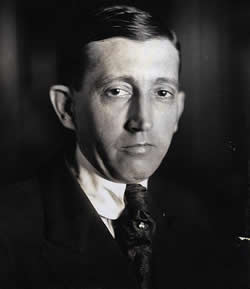Production Codes
 Threatened with legislation, the movie industry policed itself. In 1922, the studios got together to create their own censorship office, the Motion Picture Producers and Distributors Association (MPPDA).
Threatened with legislation, the movie industry policed itself. In 1922, the studios got together to create their own censorship office, the Motion Picture Producers and Distributors Association (MPPDA).
They selected William Hays, former RNC chair and former Postmaster General to lead the MPPDA, which became known as the Hays Office.
Hays was chosen for his upright image. However, between 1922 and the early 1930s, censorship was relatively light.
This changed in the 1930's, largely under pressure from the Catholic Church. The "Motion Picture Production Code" was published in 1930 but was ineffective until about 1934. Then, faced with a threat of a Catholic boycott, it began to be enforced.
In 1951 a revision of the code made it even more rigid and US movies entered a period of maximum censorship. But, by the late 1950s, with the overturning of Mutual Film Corp. v. Industrial Commission of Ohio, censorship lightened.
Next: current day censorship
 The picture at the top is William H. Hays. Like I said above, for much of the public, Hays seemed an appropriate man for the job. In reality he was deeply corrupt. As chairman of the Republican Party and then later Postmaster General, he had played a key (and dishonest) role in the Teapot Dome scandal of the early 1920s. In a review of a book about Teapot Dome, William Grimes writes, "Hays skulks and slithers. A wizened sourpuss, up to his elbows in dirty deals, he flies out to Hollywood like one of the winged monkeys from “The Wizard of Oz” after serving as postmaster general..." So, Hays approach to censorship was largely cynical. One perhaps apocryphal quote is: “When you make a woman cross her legs in the films, maybe you don't need to see how she can cross them and stay within the law; but how low she can cross them and still be interesting." In other words, he was fine with sex in films, it just had to be implied rather than directly shown.
The picture at the top is William H. Hays. Like I said above, for much of the public, Hays seemed an appropriate man for the job. In reality he was deeply corrupt. As chairman of the Republican Party and then later Postmaster General, he had played a key (and dishonest) role in the Teapot Dome scandal of the early 1920s. In a review of a book about Teapot Dome, William Grimes writes, "Hays skulks and slithers. A wizened sourpuss, up to his elbows in dirty deals, he flies out to Hollywood like one of the winged monkeys from “The Wizard of Oz” after serving as postmaster general..." So, Hays approach to censorship was largely cynical. One perhaps apocryphal quote is: “When you make a woman cross her legs in the films, maybe you don't need to see how she can cross them and stay within the law; but how low she can cross them and still be interesting." In other words, he was fine with sex in films, it just had to be implied rather than directly shown.
 Threatened with legislation, the movie industry policed itself. In 1922, the studios got together to create their own censorship office, the Motion Picture Producers and Distributors Association (MPPDA).
Threatened with legislation, the movie industry policed itself. In 1922, the studios got together to create their own censorship office, the Motion Picture Producers and Distributors Association (MPPDA). The picture at the top is William H. Hays. Like I said above, for much of the public, Hays seemed an appropriate man for the job. In reality he was deeply corrupt. As chairman of the Republican Party and then later Postmaster General, he had played a key (and dishonest) role in the Teapot Dome scandal of the early 1920s. In a review of a book about Teapot Dome, William Grimes writes, "Hays skulks and slithers. A wizened sourpuss, up to his elbows in dirty deals, he flies out to Hollywood like one of the winged monkeys from “The Wizard of Oz” after serving as postmaster general..." So, Hays approach to censorship was largely cynical. One perhaps apocryphal quote is: “When you make a woman cross her legs in the films, maybe you don't need to see how she can cross them and stay within the law; but how low she can cross them and still be interesting." In other words, he was fine with sex in films, it just had to be implied rather than directly shown.
The picture at the top is William H. Hays. Like I said above, for much of the public, Hays seemed an appropriate man for the job. In reality he was deeply corrupt. As chairman of the Republican Party and then later Postmaster General, he had played a key (and dishonest) role in the Teapot Dome scandal of the early 1920s. In a review of a book about Teapot Dome, William Grimes writes, "Hays skulks and slithers. A wizened sourpuss, up to his elbows in dirty deals, he flies out to Hollywood like one of the winged monkeys from “The Wizard of Oz” after serving as postmaster general..." So, Hays approach to censorship was largely cynical. One perhaps apocryphal quote is: “When you make a woman cross her legs in the films, maybe you don't need to see how she can cross them and stay within the law; but how low she can cross them and still be interesting." In other words, he was fine with sex in films, it just had to be implied rather than directly shown.